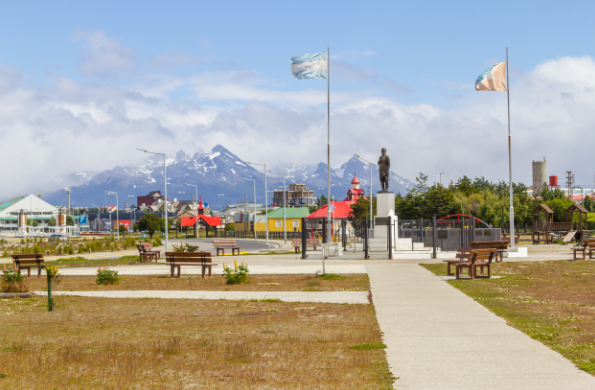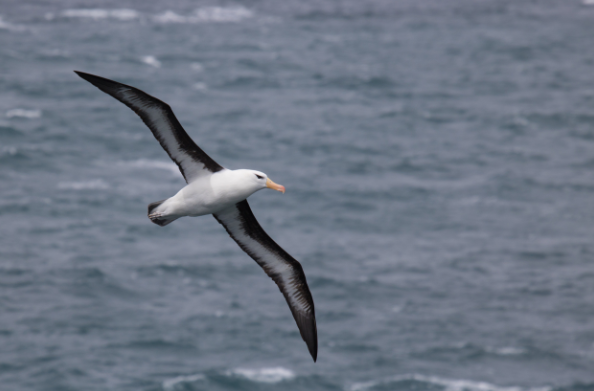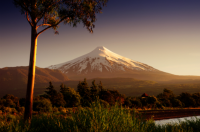Tierra del Fuego is an archipelago at the very tip of South America, divided from the mainland by the Strait of Magellan. The largest island is Isla Grande de Tierra del Fuego, with other smaller islets including the Diego Ramírez Islands, Darwin Island and Cape Horn. Chile and Argentina share the province; however, the islands have a distinct identity, including their own Tierra del Fuego flag. Full of symbolism, the standard of Tierra del Fuego describes the landscape and culture of these beautiful islands.
Features of the Tierra del Fuego flag

Argentine architect Teresa Beatriz Martínez designed the Tierra del Fuego flag in 1999. Her design includes the colors blue, orange and white, with an albatross swooping across the center. Rendered in an abstract style, the bird’s wings spread diagonally across the banner. In addition, above the albatross are five stars that represent the Crux constellation.
The Albatross
The albatross is the largest flying bird on Earth, with a wingspan of approximately three and a half meters. The bird is of particular significance to Tierra del Fuego, as the islands are an important nesting site for these magnificent creatures. Consequently, Tierra del Fuego is one of the few places people can see albatrosses up close, as they rarely come ashore. The bird’s wings are spread across the flag representing freedom and its usual habitat of the vast skies of the Antarctic seas.
The Crux
The Crux – or Southern Cross in English – is an important symbol for many places in the southern hemisphere. The stars of the Crux appear on the flags of Australia, Brazil, New Zealand, Papua New Guinea, and Samoa, as well as Tierra del Fuego. In southern Argentina and Chile, gauchos would use the constellation for orientation when traversing the vast Patagonian plains on horseback.
Sea and Sky
Tierra del Fuego is known for its wild seas, big skies, and the fascinating wildlife that inhabit them. As implied by the significance of the albatross, the archipelago plays host to unrivaled birdwatching. Equally, the islands are home to incredible marine life, including seals, whales, and dolphins. What’s more, the archipelago is a place where Mother Nature truly demonstrates her might, with summertime blizzards and the fierce williwaw winds. With the sea and skies shaping so much of what makes the region unique, representing them on the Tierra del Fuego flag seems only appropriate.
Fire
The English translation of Tierra del Fuego is ‘Land of Fire’. Portuguese explorer Ferdinand Magellan – who also gave his name to the Strait of Magellan – named Tierra del Fuego. When approaching the islands on his ship, Magellan thought he saw many fires burning in the distance. These fires were lit by the Yaghan people, native Fuegians. Therefore, the orange in the Tierra del Fuego flag represents fire, commemorating the archipelago’s naming.
Tierra del Fuego: Rich culture and incredible nature

Tierra del Fuego is significant to cultural and natural history for numerous reasons. From the ancient customs of the Yaghan and Selk’nam people to Charles Darwin’s discoveries, there is plenty of fascinating history explore. Furthermore, Tierra del Fuego is an unmissable location for nature lovers, with once-in-a-lifetime opportunities to observe some amazing wildlife. To find out more about Australis’s tours of Tierra del Fuego, take a look at our brochure.
No comments yet
There are no comments on this post yet.






Leave a comment